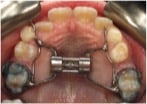What Are Orthodontic Expanders Used For?
“My daughter is 9 years old and her adult teeth are already crowded. Her upper back teeth also bite inside her lower back teeth. My orthodontist said this is called a crossbite, and recommended that she get an expander to fix it. How does this work?”
Orthodontic expanders are used to separate the right and left sides of the upper jaw, in order to increase the width of the upper arch.
Orthodontic expanders are a common orthodontic appliance used to widen the upper jaw in growing children. When you feel a baby’s head, you can feel the soft spots where the bones of their skull have not yet completely fused together. The right and left side of the upper jaw bone, or maxilla, are connected by an area of cartilage which doesn’t fuse until puberty. Orthodontic expanders are used to separate the right and left sides of the upper jaw, in order to increase the width of the upper arch. The expander stretches the midline suture, and this causes new bone to be deposited in the midline of the palate. Expanders are most commonly used in children between the ages of 7 and 11, before the complete fusion of the suture.
There are two main types of expanders:
– rapid palatal expanders
– slow palatal expanders
 Rapid expanders, which are most common, are held in place with bands around the adult molars and are bonded in place – they cannot be removed by the patient. They sit in the palate and are not visible from the outside. There is a screw in the middle of the appliance. The screw is generally turned by a parent once a day with a special key – for about 3-4 weeks. The expander is then left in place in the child’s mouth for another 3-6 months, to allow the new bone to deposit along the suture and maintain the new width.
Rapid expanders, which are most common, are held in place with bands around the adult molars and are bonded in place – they cannot be removed by the patient. They sit in the palate and are not visible from the outside. There is a screw in the middle of the appliance. The screw is generally turned by a parent once a day with a special key – for about 3-4 weeks. The expander is then left in place in the child’s mouth for another 3-6 months, to allow the new bone to deposit along the suture and maintain the new width.
 Slow expanders are usually a removable retainer which also includes a screw in the midline. These are removed and replaced by the patient throughout the day. They are meant to be worn full time, other than when eating and brushing.
Slow expanders are usually a removable retainer which also includes a screw in the midline. These are removed and replaced by the patient throughout the day. They are meant to be worn full time, other than when eating and brushing.
Turning the key in the expander doesn’t hurt – some kids feel pressure for a few minutes after the key is turned, and most feel almost nothing at all. Getting used to the expander can be quite a challenge though – most kids don’t eat much for the first week while the expander is in. I have had worried parents wonder if it will ever improve, and within a few days, their kids are back to normal! The only foods that have to be avoided while the expander is in place is anything very sticky (like taffy candy and gum) – as this can pull the expander off the teeth. So remind your child that it will get better soon, prepare healthy smoothies and soups for the first few days, and you will all be back to a normal routine within a week!
Why is an expander important?
– Expanders can be used to resolve crowding during the mixed dentition stage (when some adult teeth have already come in and some baby teeth are still present). It can often make the difference between needing to extract adult teeth and not needing to extract teeth in the future.
– A crossbite left untreated can cause asymmetric jaw growth and jaw joint (or TMJ) problems. Crossbites are easily corrected with expanders.
– Expanders create more space in the mouth for the tongue and for breathing. Narrow jaws are often due to mouth breathing, and narrow jaws can also be a factor leading to mouth breathing. It is a chicken and egg issue – we don’t usually know which came first, but we know they are related. If your child has a narrow upper jaw and also has difficulty breathing at night, or you notice noisy breathing or mouth breathing, an expander may be a great tool to improve this for them!
This is an example of the changes an expander can make in an 8 year old’s smile!


Common question that comes up during expander treatment
– My child’s two front teeth now have a giant gap between them! Will this ever close?
Yes! During the active expansion phase (the 3-4 weeks of active key turning), a gap will appear between the two central incisors. This is a great sign that the expander is working! This gap will close on its own within 2-3 months, as the elastic fibres in the gums between the teeth bring the teeth back together.
Good habits for kids
As always, ensure you are deep cleaning teeth with a kids electric toothbrush or manual brush. Bacteria can lurk between the appliance and the teeth, so keep them clean!
Want to learn when your child should see an orthodontist? Good teeth brushing skills?










